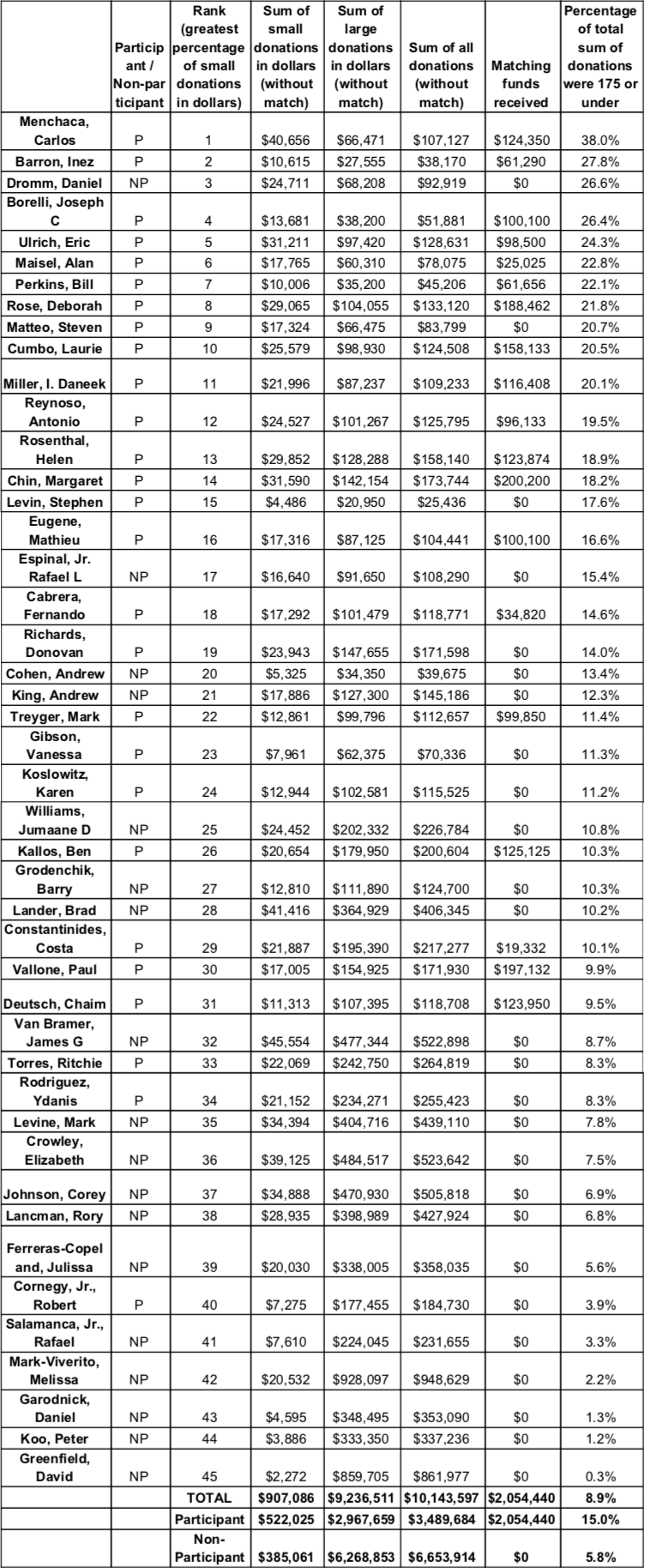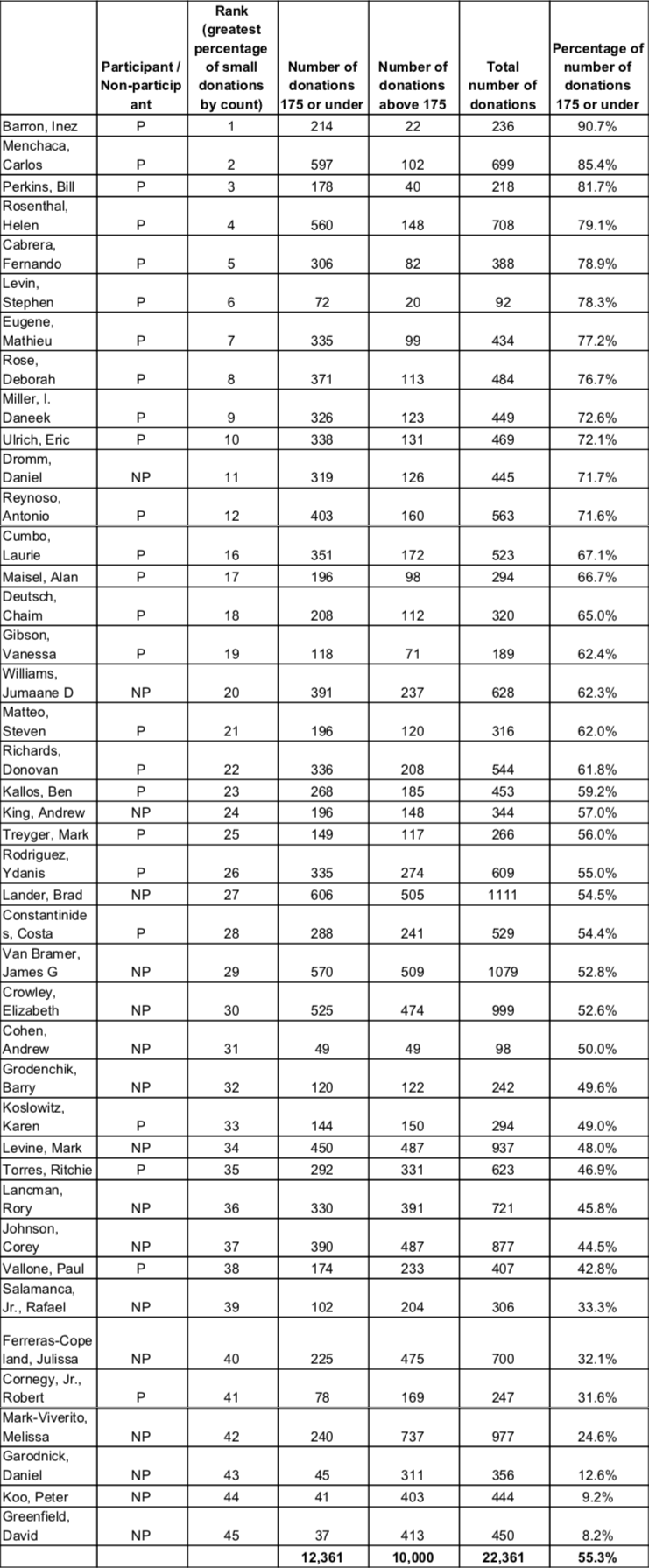City Council Raises 91 Percent of Campaign Cash from Larger Donations
City Council Raises Most of Campaign Cash from Larger Donations
91 percent of contributions to Councilmembers are larger than $175
Groups call on Speaker Mark-Viverito to allow vote on Int. No. 1130-A to better incentivize raising small donations
A joint analysis by Represent.us NY and Reinvent Albany reveals that City Council- members collectively raised 91 percent of their campaign funds from contributions over $175. Councilmembers rely on larger donations to fund campaigns even while the city’s voluntary public matching funds program enables Councilmembers to receive $6 in matching public funds for every $1 raised up to $175.
Forty-five Councilmembers actively fundraising in the 2017 election cycle raised a total of $10.1 million for office, $12.2 including public matching funds. Only $907,086 was raised in contributions of $175 or less while $9.24 million was raised in contributions larger than $175. $2,054,440 was given in public matching funds. The first $175 of all contributions is matched regardless of how large or small a contribution is.
Even when considering higher contribution thresholds of $500 and $1,000, Councilmembers still raised 72 percent and 59 percent of their money from contributions above those amounts, revealing the Councilmembers’ reliance on larger contributions to fund their campaigns.
Represent.us NY and Reinvent Albany, along with numerous other local and national organizations, support passage of Int. No. 1130-A. The bill would make it easier for candidates to raise more money from small donors. It would enable candidates to voluntarily raise all their funds from small donations matched at a rate of $6 in public funds for every $1 raised, and receive as much as 85 percent of their total funds in public dollars, an increase from the current 55 percent.
The bill has 30 co-sponsors in the Council, but Speaker Melissa Mark-Viverito has yet to put the legislation on the floor for a vote. The groups call on her to do so.
Under the current system, candidates may receive up to 55 percent of the spending limit for their office from public funding after meeting certain fundraising thresholds. For City Council candidates to qualify for the public matching program, they must raise at least 75 small donations (up to $175) from contributors within their district. Candidates who chose to forgo the public matching system are not subject to spending limits but must abide by contribution limits for the office they seek.
“The city’s campaign finance system is a model for the country because most Councilmembers receive more than half their donations from small donors,” said Alex Camarda, Senior Policy Advisor for Reinvent Albany. “Yet most of the money Councilmembers raise is from larger contributions above the $175 eligible for a public match. We therefore need to change the system to better incentivize raising more money from small donors.”
“Even for those who follow New York City campaign finance, the amount of larger donations raised is surprising,” said Tom Speaker, a leadership team member of Represent.us’s volunteer New York chapter. “The city has one of the most progressive systems in the country, but it is exceedingly difficult to win office without seeking help from donors with deeper pockets. Increasing the amount of public funding for elections would reduce candidates’ dependency on wealthy donors and empower the ordinary New Yorkers who comprise most of the city’s electorate.”
The analysis also found:
- Only 4 of 45 Councilmembers actively fundraising this cycle raised more than 25 percent of their money from small donors.
- Thirty four of 45 Councilmembers raised less than 20 percent of their funds from small donors ($175 or less).
- Twenty seven Councilmember participating in the public matching system together raised 15 percent of their funds from small donations, while 18 non-participant Councilmembers raised 5.8 percent of their funds from small donations.
Councilmembers ranked by funds raised from small donations as a proportion of all funds
Six Councilmembers did not have active 2017 campaigns.
Not all candidates who were participants in the public matching funds program received matching funds.
Some Councilmembers, like Melissa Mark-Viverito and Dan Garodnick, raised funds for offices other than Council which have higher contribution limits than the Council.
Even while most Councilmembers’ campaign money comes from larger donors, many Councilmembers receive a majority of their contributions from small donors. Thirty-one of 45, or 69 percent of Councilmembers, raised at least half of their donations from small donors, as shown on their chart below. Overall, Councilmembers raise 55 percent of their contributions from small donors. Participants in the public matching system raise 66 percent of their contributions from small donors, while non-participants raise 44 percent.
Councilmembers ranked by the number of small donations as a percentage of all donations
Six Councilmembers did not have active 2017 campaigns.
Some Councilmembers, like Melissa Mark-Viverito and Dan Garodnick, raised funds for offices other than Council which have higher contribution limits than the Council.
This analysis was completed using data from the New York City Campaign Finance Board, downloaded on December 8, 2017.
Reinvent Albany is a non-profit group that advocates for open and accountable NY government, and is one of New York’s leading voices for Freedom of Information Law, open data and online transparency.
Represent.us is the nation’s largest anti-corruption campaign, bringing together conservatives, progressives and everyone in between to pass anti-corruption laws in cities and states across the country. Anti-corruption laws stop political bribery, end secret money, and fix our broken elections. Represent.us NY is the New York chapter of Represent.us consisting entirely of volunteers.
Both organizations thank the New York City Campaign Finance Board for their assistance in reviewing the campaign finance data used in this report.
-30-



